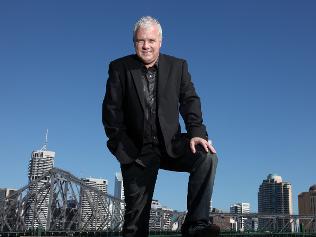Tales of the city
Matthew Condon's literary 'love letter' to Brisbane is set to reignite debate about the Queensland capital's historical origins.

Matthew Condon's literary 'love letter' to Brisbane is set to reignite debate about the Queensland capital's historical origins.
HOW does one write a book that captures a whole city? This is the question that confronted Queensland writer Matthew Condon, who describes the opportunity to write Brisbane, the second book in publisher NewSouth's series devoted to Australian capital cities, as the "singular most simplistic, liberating brief that I've ever received".
Commissioning editor Philippa McGuinness told Condon to approach the book any way he wished, "which on the one hand is brilliant", says the author, "but on the other, when you come down to writing [it], trying to put your arms around an entire city, it was very difficult. I deliberated for months and months: how do you go about it? Then I decided that it really is impossible to do it thoroughly. It would be endless. The city is organic. It's constantly shifting and changing. So I had to give myself limitations."
Eventually, Condon decided to ground his book in an examination of the location where explorer John Oxley first landed on the Brisbane River in 1824. "I decided, 'Look, I'm going to go to where X marks the spot, where Oxley came ashore. That's the Caucasian history of the city. I'll start there, and I'll see where it takes me'." Notebook and camera in hand, the author visited the granite monument. Located at North Quay, which was erected to celebrate the centenary of Oxley's landing, he says "it's possibly the most unimaginative foundation stone of any city in the Western world . . . I stood there with the traffic roaring on both sides, and something about it struck me as wrong.
"The wording on the monument, 'Here John Oxley Landing (sic) to Look for Water Discovered the Site of this City' was sort of hesitant; it didn't feel right. So I thought, 'Okay, this is where I start. I'll investigate the monument.' And that kicked the journey off, really."
Condon admits that the city's residents may disagree with or be offended by some of his findings in Brisbane, which includes painstakingly cross-referenced evidence that casts doubt on the commonly held belief that Oxley landed at North Quay. But Condon says that "that's indicative of a grown-up city. We should be debating, questioning ourselves, tilling the soil, and asking these things of each other, because that's what a civilised community does."
McGuinness suggests the inspiration behind The City Series is literary, rather than "some pointy-headed urge to make a grand statement about Australia's cities. Cities are great subjects for literary nonfiction; most of us live in them but they are usually given the guidebook treatment rather than being great pieces of writing", she says. "So often cities are labelled as being cosmopolitan, or global, or one of the world's 'most liveable' as if they're part of a huge marketing exercise in which we're all implicated. But what does this mean for those of us quietly going about our lives on the ground?"
McGuinness commissioned six writers for the series. Peter Timms's In Search Of Hobart was released last year; following Condon's Brisbane, Delia Falconer's Sydney is due in October, while Sophie Cunningham's Melbourne, Wendy Were's Perth and Kerryn Goldsworthy's Adelaide are all scheduled for release in 2011.
McGuinness expresses an overarching desire to publish writers who feel passionately about where they live: "I didn't want the books to feel like they were written by the local tourist authorities, but then again, I didn't want the authors chased out of town."
McGuinness suggests people tend to think of the NSW capital as the glitziest of them all. Peter Carey's Thirty Days in Sydney and John Birmingham's Leviathan have attempted to capture the sprawling city as it changes. In contrast, McGuinness believes Falconer's account will be "the most melancholy book in the series; one that depicts a city divided between its wild past and a covert desire to be loved".
Condon, who was born in Brisbane in 1962, believes his decision to leave the city for "important years" in his life put him in a unique position: he was able to return and see demonstrable change. "But the Brisbane light, the feel, the weather, the lushness, the vegetation; that's the same as when I was a kid. Other things change around it; it was unique to get that perspective in the sense that I did come back to [the city] with fresh eyes. It may have been a very different book if it had been written by a writer who had stayed here."
His take on the city toes the line between memoir and historical document. Once he started writing, Condon found that a first-person perspective simply wasn't working. "I started writing about myself, and it just died on the page," he reveals. Without wanting the book to appear self-indulgent or worse, dull, the author soon realised that employing a fictional technique "unlocked everything". Instead of writing through his eyes, he described a boy, largely based on himself, growing up in Brisbane.
"The minute I stood back from that boy, all the fine details, the smells, the senses, everything came in. When I stood back and looked at myself as a separate figure, all these memories and things that I hadn't thought about since I was five years old rushed in. That's the liberation of using a fictional technique on fact."
The structure of Brisbane is unconventional; it contains no chapter breaks, for instance, because he wanted the present and the past to "constantly chafe against each other". He encourages the reader to question whether elements of the past are still visible in the city's present. "I wanted the book to move back and forth in time," he explains. "So I structured it in a way that would meander. I tried to stitch a few thematic links through it, so that rather than a dreary history of a city, it would have at least a few narrative lines to pull people through it."
Given the author's day job as a feature writer for The Courier-Mail's glossy magazine, Qweekend, the offer to write at length about his home town is a perfect fit: through the lens of investigative journalism, Condon has spent the last five years in the Queensland capital writing about the city's past, its present, and its inhabitants. Several of his long-form Qweekend features are threaded throughout Brisbane, including a heavily researched piece on the 150th anniversary of Queensland's separation from NSW.
Condon is an acclaimed fiction writer. His first novel, The Motorcycle Cafe, was shortlisted for the 1989 NSW State Literary Award for Fiction, and in the 1990s, A Night at the Pink Poodle and The Lulu Magnet won back-to-back Steele Rudd Awards for short fiction. His most recent novel, The Trout Opera (2007) was shortlisted in the Queensland Premier's and NSW Premier's literary awards.
Condon admits that he viewed Brisbane as an opportunity to write his way back into the city. "In those first couple of years after I returned, I'd driven past my childhood house several times," he says. "It was me trying to reconnect with a city that I'd lost touch with for 18-odd years. And something deep inside of me told me to do this book, because perhaps it would embed me back into Brisbane. In many ways, it did that."
These feelings of rediscovery and belonging are echoed by Peter Timms, author of In Search of Hobart. Timms describes himself as a relative newcomer to Hobart, having lived there for nine years; as a result, he found researching and writing the book "a marvellous way of getting to know it. I feel much more now that I belong," he continues, "and that I have a richer understanding of its history and society. I feel I've put down roots. I was delighted that In Search of Hobart was published as the first in the series, because we in Hobart always seem to come last at everything."
Timms believes the series will be a wonderful way to make comparisons between Australia's capital cities. "If this series can open our eyes to the particular attributes of cities other than our own, it will have helped give us a more complex and subtle awareness of the nation as a whole," he says.
Condon hopes that the book "gives people a sense of what Brisbane has been like, and what it's like to live here. I would hope that it gives them that deep connection to their heart, rather than just their head". When asked whether Brisbane could be considered a love letter to his home town, he laughs and replies: "Yeah, in the way that some love letters are raw and honest, and can be confusing and upsetting.
"If it's a love letter, its heart is in the right place."
Brisbane by Matthew Condon, NewSouth, 312pp, $29.95 is released on Monday.



